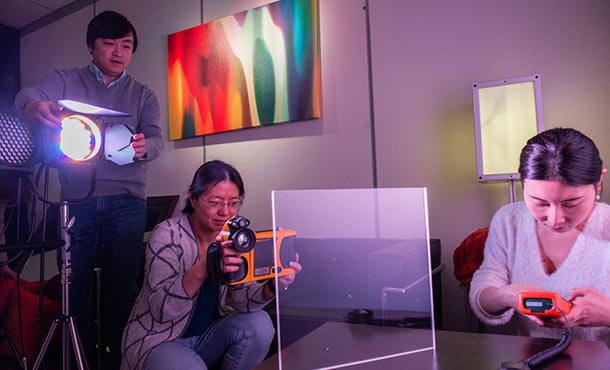
Julian Wang, associate professor of architectural engineering, tests properties on a pane of glass with doctoral students Qiuhua Duan, center, and Yanxiao Feng, right. IMAGE: TYLER HENDERSON
Architectural engineering professor continues work on sustainable windows
1/17/2020
By Mariah Chuprinski
UNIVERSITY PARK, Pa. — Windows accentuate and beautify commercial or residential buildings, according to Julian Wang, associate professor of architectural engineering at Penn State, but they also are vulnerable to the elements: Sunny days cause brighter and warmer rooms, while colder, darker weather conditions can make rooms chilly. Consumers may use blinds or shades to block or take in light, but those solutions limit visibility.
“Energy-wise, the window typically is the weakest component of a building, because it’s really easy to have heat loss or heat gain, and it is more sensitive to solar radiation,” Wang said. “But windows are also visual. They affect user comfort, productivity, and building-facade aesthetics.”
Wang has focused his academic career on researching lighting, daylighting and sustainable building materials, including innovative dynamic windows that can absorb and deflect solar infrared energy, or heat.
In 2016, as an assistant professor at the University of Cincinnati, Wang was awarded a three-year, $350,000 grant from the National Science Foundation (NSF) to research glazing materials alongside materials scientists. He developed a thin, barely visible nanofilm made of light-interactive nanomaterials, which can selectively respond to infrared rays.
Even with that success, there is still a challenge to take those glazing materials from the nanoscale and apply them to commercial building windows. Wang will address that issue as he continues his research through a $500,000, five-year NSF CAREER project awarded last year.
“To go from the nanoscale to the building scale, the understanding of complex collective effects among the nanofilms, windowpanes, the central air layer, the low emissivity coating and the window’s environment is needed,” Wang said. “Many nanomaterial scientists are developing this kind of material, but we don’t yet have appropriate methods to incorporate them. That is what we are looking into.”
In his project, Wang said he will test these window glazing materials that could, in the long term, be used to produce dynamic windows that adapt to climate conditions in real-time. By transmitting infrared energy indoors in the wintertime and deflecting it in the summertime, dynamic windows would reduce total building energy consumption.
Additionally, these windows would maintain clarity and transparency without the visual tradeoffs of tinted or screened windows, increasing the comfort of a building occupant.
Still in the early days of development, these dynamic windows will be positioned for research in a mockup studio for Wang and his graduate students to fine tune their functionality.
“We’ll set up a full-scale mockup space which has two rooms of windows with walls, a controlled room, a thermal chamber and a lamp that has an identical spectrum as solar energy and can move on tracts to recreate the movement of the sun,” Wang said.
In addition to his technical research, Wang plans to develop “Measure Your Glass,” an outreach program aimed at introducing sustainable building technologies, such as dynamic windows, to K-12 students and undergraduate college students. Wang hopes to specifically target underrepresented groups. Program participants will work in a lab, measuring glazing properties of windows using a custom measurement system and sensors. Through this initiative, Wang hopes to increase public awareness of the importance of sustainable building materials including energy-efficient windows.
“Julian is conducting fundamental research to develop new glazing materials to improve the daylighting and thermal performance of windows. This is a critical research effort to achieve ultra-high-performance buildings,” said Sez Atamturktur, Harry and Arlene Schell Professor and head of the Department of Architectural Engineering. “We are excited to see where the research leads him.”




